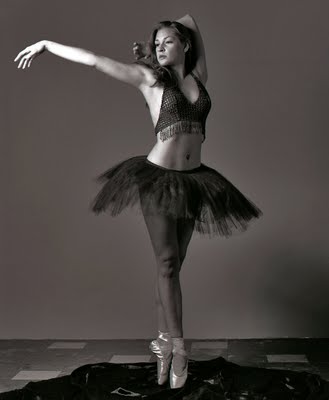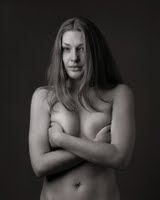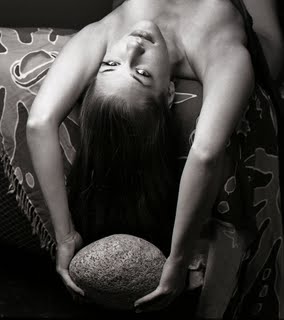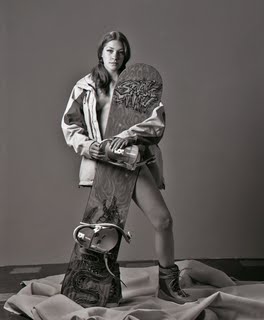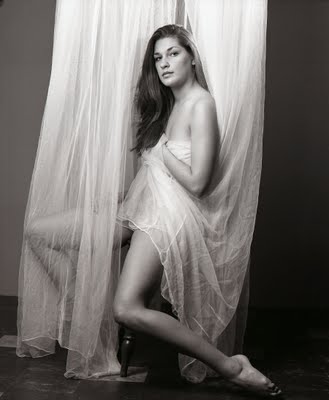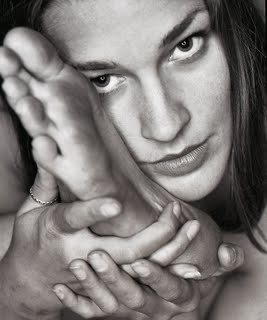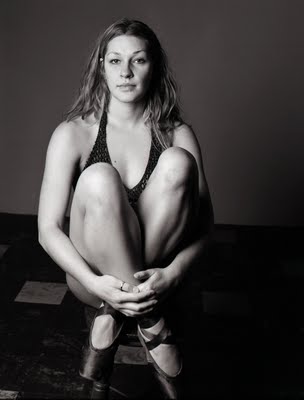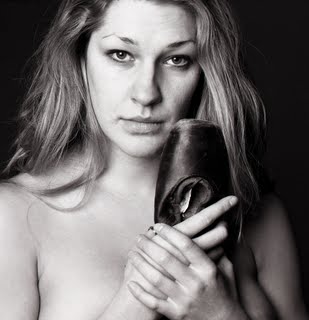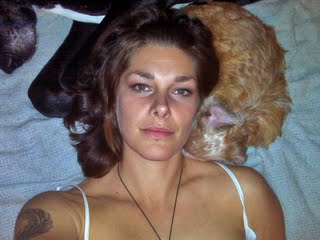Bloom's Spoons
Thursday, October 15, 2009
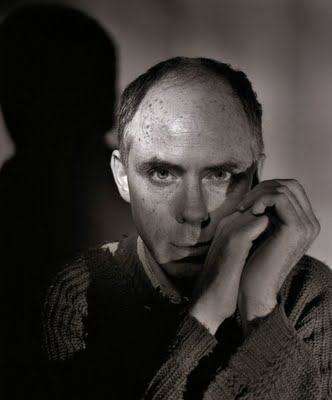 Theatre is much like film. Casts and the crew who work with them have a pecking order. There are positions in film like the grips. I have no real idea of what they do. Do they hold things? Many in theatre, like in film, are essential, some are also unsung. One of them is the Fight Director. In films like The Matrix we would all understand that the Fight Director or fight sequence director would be most important. A broadsword fight in a Bard of the Beach production of Macbeth would also be on that same league. 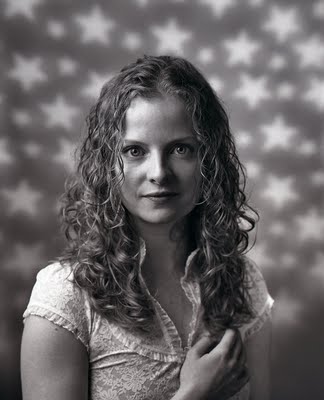 Then you go with your daughter, as I did tonight, to the opening performance of American playwright William Gibson’s, The Miracle Worker presented by the Vancouver Playhouse Theatre Company. You would never consider that a fight director would have any kind of relevance in a play based on the early life of Helen Keller. Fight scenes here? Impossible! Yet there are fights in this extremely fine production directed by Meg Roe (I remember her well from her killer role as an actress playing an autistic youth in the recent Vancouver Playhouse production of Toronto, Mississippi) which use scissor, spoons and other thrown objects that are so central to this play that without them The Miracle Worker would fizzle. It is a fight between a headstrong little girl who is unable to connect between the signs for letters, and the real objects, things and people they define, and a just-as-headstrong woman of 20 (not a teenager!) with a past that might just prevent her from finding a solution to the process of thought through language. 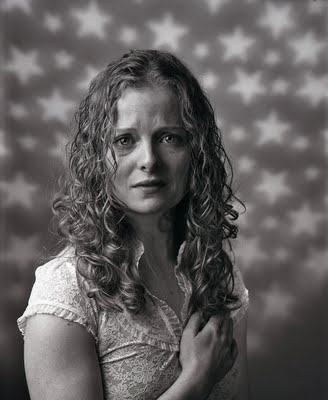 The unsung hero of that virtuoso spoon fight is Fight Director David Bloom seen here in picture above left. During the scuffle for the fallen spoon the theatre was so quiet that all I could hear was that spoon drop. Two little girls play Helen Keller, Margot Berner and Emma Grabinsky. If I understand well my program notes my daughter Hilary and I saw Margot Berner tonight. She was superb in her battle of wits with her nurse and teacher Annie Sullivan played by Anna Cummer. I must diverge here to give my account of my extraordinary experience in having Cummer in my studio back in 2005. I happened to ask her if she could cry on demand. I had been lucky before in that I had photographed two acresses who could do just that. Cummer looked at me and left the studio. A few minutes later she returned and stood in front of my camera with a face that was ravaged by sorrow. Little tears began to pour down her eyes. In this production of The Miracle Worker all the other actors, Hamza Adam as Percy/Doctor, Tom Butler as Captain Keller, Jennifer Clement as Kate Keller, Marci T. House as Viney and Bridget O’Sullivan as Aunt Ev were good given that it was just about impossible to compete with Cummer and Berner's strong performances in roles designed to be just that. 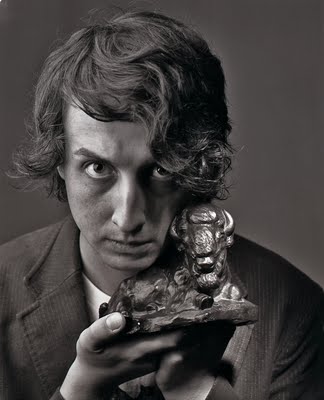 For me there was one other actor who stood out. He is one of my favourites in town. Ryan Beil played James Keller, a young man who does not seem to know how to please his father. Beil has a kind of Stan Laurel universal face that can adapt to any situation. I thought he was excellent in the Main Street Production of Glengarry Glen Ross. I ache to see Beil in a comedy that goes beyond the role limitations of this summer’s Bard on the Beach production of The Comedy of Errors. Beil can be funny and especially so if let loose! As Hilary and I watched the battle of wits between little Helen Keller and Annie Sullivan I kept whispering in her ear, “Lauren and Rebecca (my granddaughters and Hilary’s daughters) are easy in comparison to this!” It was around 11pm that Hilary called to say, “Lauren was impossible. She threw pens and pencils with such force against the kitchen stove, that she broke them. She refused to write down anything for her dictée. Her father has grounded her, including no TV until Monday.” I wonder if David Bloom might have approved. In the play Annie Sullivan says, "Obedience without understanding is a blindness, too." What would Sullivan have opined on grounding?
Tuesday, October 13, 2009
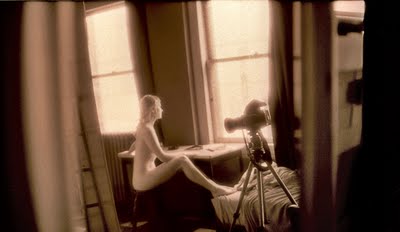 For many years I have put all my photographic eggs into the medium format basket. This means that I have taken most of my photographs with a Mamiya RB-67 with its 6x7 cm transparency or negative. Whenever I hold a 35mm camera, even that extra heavy tank that my Nikon F-3 with a motor drive is, I feel I am holding a toy. When all my printing happened strictly in the darkroom there were many negatives and transparencies that never saw the light of day. Now I like to make myself a large and strong cup of tea and look at some of my negatives wit a loupe. I am putting an extra effort into looking at pictures I took with those “small” cameras. Often the best excuse for using a 35camera (and still is) was its ability to let me shoot unburdened by a cable to a flash system. There was another excuse and that was Kodak Infrared b+w film. Alas it has been discontinued! 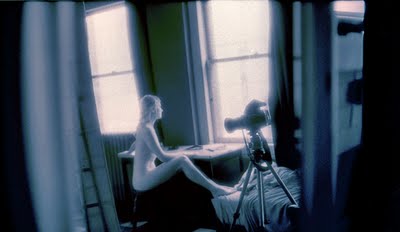 If you overexposed it a bit (or a lot) you got light going through the film and bouncing back from the pressure plate in the camera. The effect was a light halo in dark areas. The effect was and is called the halation effect. Many film manufacturers in an effort to “improve” the film started putting anti-halation layers on to their film base. Luckily Kodak never tried to do that with their infrared film of which I have about 35 rolls left in my fridge. Kodak b+w InfraredMore Infraredand more
Lauren & Pancho El Esqueleto
Monday, October 12, 2009
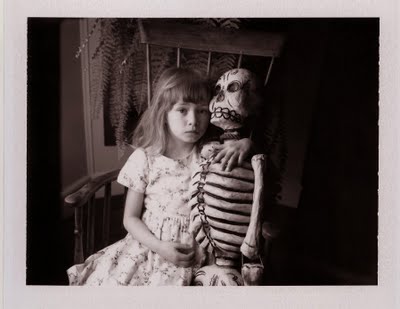 Rosemary and I worked in the garden today and I think both of us became melancholy as we saw our garden in decay. It is about this time (before all those rains come) that we change our mind about some plants and move them around. Some plants have gotten so big that they need to be divided and moved. The fall garden, after a while, looks like it’s been worked on. But the melancholy, at least for me, dissipates as I notice all the warm browns, yellows and reds of our plants, thistles and hostas. Many of the roses are full of hips this year. A few of the them surprise me with blooms here and there. I walk into the house and I go to our busy but friendly living room and I notice Abraham Rogatnick’s life-size papier mache esqueleto (squeleton) that peacefully reposes on my psychiatric couch. We have affectionately called him Pancho and he still has the thick rope around the neck. Abraham bought Pancho in Mexico sometime in the 50s. Last year when Abraham had a premonition of his death (he died last month) he started giving some of his stuff away. I was the lucky recipient of Pancho and the rope which Abraham used to hang him from his door for Halloween. He (Pancho) is much too precious that I would ever consider hanging him outside for the forthcoming Halloween. He will be safely inside. Perhaps it was last fall that I photographed Lauren with Pancho. It was this first Polaroid (and alas, one of my last Polaroids as the Polaroid Company went the way of Packards and Studebakers, De Sotos and Oldsmobiles, not to mention Minoltas ) that I was happy with and here it is. Lauren has informed me that this year she is going to dress up as a witch for Halloween. As for me I am literally closing one Andrea Camilleri book (all checked out from different branches of the Vancouver Public Library) to open the next. I have been keeping it at one a day. I am into the 8th tonight ( The Scent of the Night). I feel that Salvo Montalbano and I are friends. I long to have him show me around his home town of Vigata right in the middle of a hot Sicilian summer. But I would starve as Montalbano loves fish and I don't. I wonder what Sicilians like for dessert? Vigata è una cittadina immaginaria creata dallo scrittore Andrea Camilleri, in cui sono ambientate le storie del commissario Montalbano e altri romanzi dello stesso autore. La cittadina di Vigata è sita nell'altrettanto immaginaria provincia di Montelusa. Vigata è il nome immaginario di Porto Empedocle, la città natale di Camilleri.
Inspired By Winslow Homer
Sunday, October 11, 2009
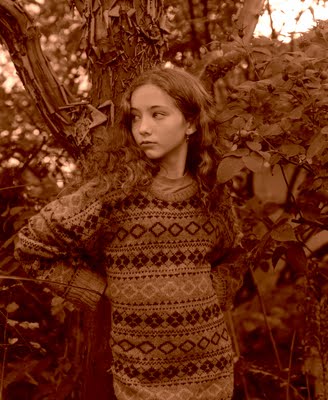 Saturday, when we celebrated our Thanksgiving had one uniquely pleasant moment that extended for the 49 minutes of Winslow Homer – An American Original a DVD film I took out from the Vancouver Public Library. In the past we had seen a series of films on composers like Bach and Beethoven involving children so that the composers were seen as humans with human foibles. These composer series had been a success but I was not ready for the sheer beauty of this one featuring Wayne Best as Homer and the wonderful Ryan DeBoer and Tamara Hope as the two children who befriend the artist who seeks escape and quiet from hauntings of the civil way battles he sketched for Harper’s Weekly. Rebecca knew a bit about my fondness for
Winslow Homer as I had taken her to Washington DC’s National Gallery to show her my favourite American painting, Right and Left by Homer when she was 6. I had to explain to her that Homer had sketched battle scenes but mostly scenes of soldiers waiting in their camps for Harper’s because there was yet no method for printing photographs onto magazines. The halftone process had to wait until the late 1870s and the photogravure was much too expensive, and it too was also only perfected in the 1870s. 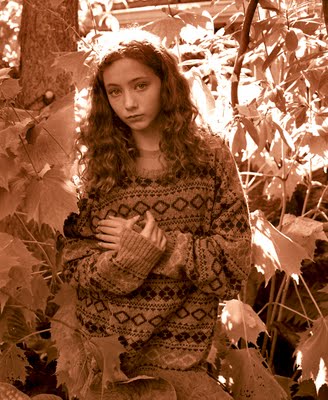 The film inspired me to take portraits of Rebecca in the garden but I was somewhat thwarted by her contemporary T-shirt and jeans. Had we only had a dress! But Rebecca is going through a period where she hates dresses and she cries and stamps her feet when I demand she wear one. This time around I covered her with an old Scottish sweater of mine. Rebecca is sensitive to wool and complained constantly on how it made her itch. Still, she did pose for me and I was able to take a few images that pleased me. I took advantage of the situation to mention the plants in our pictures which have such nice fall colours. In particular I noted the peeling bark maple or Acer griseum that Rebecca is leaning on. The other plant is a perennial called Kirengeshoma koreana. Next spring we are going to add other plants, shrubs and trees to Rebecca's present excellent knowledge of roses and hostas. I hope that spring brings a new aesthetic to Rebecca and she just might pose in dresses.
When A House Is Not A Home
Saturday, October 10, 2009
 Sometime in 1990 we started getting phone calls from the front (the Gulf War). American soldiers were given the opportunity to call their loved ones in the US to tell them that they were alive and well. These calls came from two brothers (black they were) who had befriended my oldest daughter Ale. The first time they came to our house, we had not be warned, Ale showed up with two men who looked like Pad Doc Duvalier’s Ton-Ton Macoutes. One of them was so large that his nickname was, I believe like that of American NFL player William Perry, The Refrigerator. Rosemary, my wife, coming from the small village of New Dublin, Ontario was shocked. I attempted to be more liberal and asked the boys to stay for dinner. The calls from the Gulf, to tell me that they were ok since I was supposed to be concerned as to their wellbeing, became suspect after a few weeks. It seems that the two boys had woven a story of truths and half-truths (when truth is simple it is far more fun to invent a more complicated reality) and Ale in the end kissed them goodbye. It had been in 1962 when my friend Robert had noticed I did not seem to have the capacity to make female friends. “I know of a girl who has everything you would want in one. She is intelligent and artistic.” So I had a blind date with an American black woman who was a converted Jew who told me, “My name is Benjamin but you can call me Benji.” She was pretty enough but it was difficult for me to reconcile my idea of what was beautiful with a person who had wiry kinky hair and large thick ( I could not recognize their sensuousness at the time). Wherever we walked in Mexico City we were stared at. I decided to invite Benji to visit my mother in Veracruz. In Veracruz my mother used her large house to teach the children of the executives and engineers of a large Alcoa aluminum plant there. I happened to mention to my mother that my Benji was black. My mother was most liberal and accommodating but she still said, “This friend of yours would not sit well with the people who have hired me here. I suggest you do not bring her.” I remember distinctly saying to her, “If I cannot bring my friends to your house which is my home then it is no longer my home.” The relationship ended for two reasons. Benji and I had coffee at a beatnik café in Mexico City called La Rana Sabia (the wise frog) and she told me that no woman ever had dates with a man without considering the man a potential marriageable mate. I looked at myself as she said this and decided there was too much of my life in front of me to commit to any idea of marriage. Not too long after I went to Argentina to do my military service and I kissed Benji goodbye. In Buenos Aires I received a gift subscription to Downbeat Magazine from her and then she just disappeared somewhere in Chicago. Today we had our Thanksgiving dinner because Ale drove fom Lillooet. So we had Hilary, Rebecca and Lauren ( Hilary’s husband Bruce works until late so he could not come). Our pleasant dinner was tempered by guilt in my part. A few days before Ale had called to tell us she was bringing a Japanese exchange student/teacher and that she would stay with us. We have an iffy arrangement with our upstairs bathrooms in that one of the tubs leaks while a toilet in the other does not work. This results in an awkward situation especially if we have guests we don’t know. Ale is welcome to stay but anybody else imposes stress on both Rosemary and I. Hilary had already figured out some musical beds in her own house and was willing to allow both Ale and her friend to stay. I simply told Ale that this was imposing on us and particularly on something as an intimate family dinner on the special occasion that is Thanksgiving. Ale “uninvited” her friend and arrived alone for our Thanksgiving dinner. I understand that I was wrong and that a home to be a home has to always be open to our children's friends. The other side of the family-gathering-coin is our duty in putting a bit of effort to meet new people who are friendly to our daughters and to keep that line of communication alive. I fell most guilty and for the record I will try harder the next time. Our house is not always a home. And that is tragic. The scan you see here is that of a lowly astilbe from the garden showing off its brilliant fall colouring.
Friday, October 09, 2009
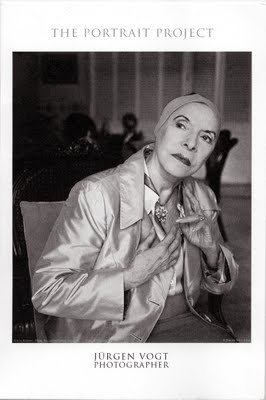 It is scary to go to an opening by a photographer who shoots b+w film and happens to just be one year older than I am. There are other resemblances but there is one difference that makes Jürgen Vogt unique. This is his penchant and talent for calmness and patience. Calmness and patience are absolutely necessary if you are going to take portraits of venerable Canadian painters, musicians, authors, poets and prima ballerinas with a 4x5 inch view camera. Vogt eschews flash and works with available light. His average exposures are ¼ second at f-8. He shoots sparingly and might have only taken four sheets (4x5 cameras are one shot cameras and you have to load them again after each exposure) of someone like Timothy Findley, Pierre Berton or, my favourite one of them all, a portrait of singer Ian Tyson. When Vogt traveled to Cuba (there is a fine display of Cuban photographers who photographed Guevara and Castro) he might have felt generous and taken 12 pictures instead of four. His portraits, at the Eastwood Onley Gallery, 2075 Alberta Street, are digital prints from beautifully scanned large-format negatives. Vogt’s subjects are treated with a respect and elegance rare in this day and age. I personally think that what he does in the age of Flickr is headed towards rapid obsolescence (redundancy in that quaint British term) and yet he maintains an easy smile on his face and there is no trace of that bitterness and anger present in so many photographers of our generation. The most striking portrait in the room (after my fave of Ian Tyson) is of the former Cuban prima ballerina and director of the Ballet Nacional de Cuba, Alicia Alonso (her full name Alicia Ernestina de la Caridad del Cobre Martínez Hoya). Not too well known is that this dancer had an acute eye problem and for the many years that she danced she was virtually blind. There is something Helmut Newtonish about the image, a sensuality, that makes me think that Vogt captured something of what Alonso must have been as a dancer when she was one of the best Giselles in the world. Best of all for me was to find out that Vogt is already planning his next project. The Portrait Project is on until October 16 and is open noon to 6pm daily.
|









